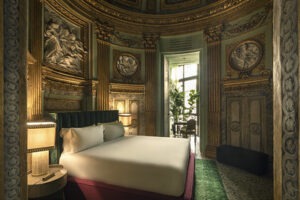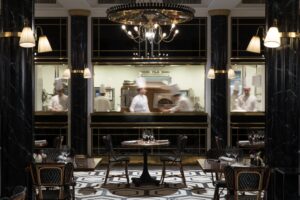Haute Living Magazine
Rome is more than Italy’s capital of history, religion, and culture; it is the scene of multiple iconic eras. Visitors can choose from Rome’s open-air archeological museums of the Roman Empire or explore the homes of dynastic families, like the Borghese and Farnese, who wielded power through ancestral popes. In the 18th and 19th centuries, Rome was the prime stop of The Grand Tour—the coming-of-age journey for European aristocrats to learn about history, literature, art, and music. And, most recently, the Eternal City held court for the movie La Dolce Vita, where Anita Ekberg waded through the Trevi Fountain, calling for Marcello.
Rome is one of the most magnificent European capitals, offering lodgings to match its majesty. Here are three luxury hotels in Rome that you need to know. Each showcases a unique and particular side of this singular city.

The Palazzo Borghese
Overlooking the Tiber River, close to the Spanish steps in the Campo Marzio area, and just a few minutes walk from Rome’s must-see landmarks, the palace was for centuries the private residence of the Borghese family, one of the most powerful and influential dynasties of 17th-century Europe.
Today, Palazzo Vilòn is believed to be Italy’s most expensive historical retreat. Its four suites can be booked together for 25,000 euros. A private dinner with a gourmet tasting menu cooked inside the vast, shiny palazzo kitchen costs an extra 1,000 euros per person and includes top wines.
The heirs of the original Borghese family – a millenary ancestry that includes popes and princes – still inhabit the attached palace. And even though individual rooms can be booked, staff tell CNN most prefer to have the whole place to themselves. Candlelit dinners are served in the Mirrors Hall, which features a long table fit for Renaissance-style banquets. The hall is decorated with bas-reliefs, golden stuccoes, and original Flemish mirrors made during the Renaissance. Florio’s team takes care of the menu and prepares iconic Italian dishes, all prepared and served by a dedicated team of waiters, sommeliers, and cooks.
Managed by the adjacent Hotel Vilòn, it has only four stunning suites. Among the highlights is the Chapel Suite, which sits inside an actual Baroque chapel with a frescoed dome ceiling overlooking a king-size canopy bed.
Guests can get pampered inside a 120-square-meter wellness space that’s accessible 24 hours a day and is equipped with a sumptuous pool, a sauna, a Turkish bath, and a hot tub. The mansion was, for centuries, the private residence of the Borghese family, one of the most powerful and influential dynasties of 17th-century Europe. Palazzo Vilon has several lounges, including Sala di Diana, pictured.
Rome’s 17th-century Palazzo Vilòn is sheer luxury. Spread across 1,100 square meters on multiple floors, it has a private gym, spa, cinema, 24-hour butler, and chefs.
This dreamy Baroque palace isn’t your usual luxury hotel. Palazzo Vilòn offers a rare chance to travel back to a time when noble families ruled the Eternal City. You’re not just paying for a place to stay, but rather the centuries of history and art reflected in the architecture and decor.
The Borghese Suite on the first floor has its own living room. The five-star hotel inside a UNESCO-listed palace
For those looking for the crème de la crème of opulence, the Borghese Palace has it in spades, plus a heavy dose of Italian history and art. The Palazzo Borghese, the former home of royalty and popes, allows living like 17th-century royalty, if only for a night. It comes with a price tag fit for a king, too, at approximately $25,000 per night.
Oh, but the history. No family represents the tie between the papacy and the Renaissance better than the Borgheses. The Borghese Family were the Medicis of Rome during the Renaissance period—they owned everything. Beyond the Borghese Gardens, Villa Borghese, and the Borghese Gallery is the Palazzo Borghese in the center of Rome. Cardinal Camillo Borghese bought the palace in the early 1600s. When he became Pope Paul X in 1605, he gave the palace to his brothers. The Pope bestowed privileges upon his family members, first naming his nephew Scipione Caffarelli, whom he adopted into the Borghese family, as Cardinal. Scipione financed the restoration and construction of many churches and palaces in Rome. His major project was to have the Villa Borghese built in Rome, where he assembled a significant collection of paintings and sculptures.
Prince Camillo Borghese was briefly married to Napoleon’s sister, Pauline. Following the 1605 election of Camillo Borghese as Pope Paul V, the family rose in wealth and fame.

Hotel de la Ville
This luxury hotel is of another era, fully modernized without losing its soul. One step outside lands you at the top of the Spanish steps and world-class boutiques like Gucci, Prada, Chanel, and the Palazzo Fendi.
Dating back to the XVIII century, the hotel came onto the scene when European nobles elected it their favorite place in Italy during the period of the Grand Tour. The building was classified as a hotel at the beginning of the ‘20s and was later expanded in the mid-twentieth century. For 300 years, until the beginning of the XIX century, young aristocratic offspring were sent to Rome to study, observe, or open their eyes to a different culture. Undoubtedly, the Eternal City had an incomparable influence on the art and architecture of Europe at the time. The design and interiors of Hotel de la Ville capture the essence of the Grand Tour with objects and works of art just like one would have found when traveling back in those times.
Ascend in the private elevator to luxuriate in your exclusive Penthouse suite in our 18th-century palazzo, spread across the entire 7th and 8th floor of Hotel de la Ville. This sensational location, with staggering panoramic views overlooking Rome’s iconic landmarks, is perfect for large groups or families. The palatial penthouse comprises three beautiful Signature suites – Canova Suite, Roma Suite, and De La Ville Suite – spread across two floors, each offering sweeping views of the city from several beautiful outdoor terraces and are fully equipped with spacious dining areas and generous living spaces. This is a Rocco Forte hotel in the beating heart of the Eternal City at the gates of the splendid Villa Borghese gardens; it’s only a few steps from some of the most important monuments.
Roccoforte transforms a staid five-star, the InterContinental De La Ville. Lavish fabrics inspired by the Grand Tour epoch combine with a collection of vintage items and unique memorabilia collected during that time. Bathrooms are carved out of Italian marble. Views over the Roman skyline or the inner courtyard complete each room.
The Hotel De La Ville offers Da Sistina, an elegant bistro facing Via Sistina, a typical neighborhood trattoria bringing classic elements from the local cuisine into a sophisticated and elegant atmosphere. The hotel’s Julep Herbal & Vermouth Bar is an exceptionally designed cocktail bar that proposes classic cocktails and creative infusions inspired by the XIII century’s “Spice Route,” a historic trade route that departed from Venice, passing through the entire European continent to reach the East. The hotel’s hotspot is the Cielo Terrace Bar—a throwback to Roman glamour with fantastic cityscape views.

Hotel Vilòn
At this new member of Small Luxury Hotels of the World, you can sleep like royalty in the 16th-century house annexed to Palazzo Borghese, the former mansion of Prince Scipione Borghese and Princess Anna Maria de Ferrari Borghese. A mansion-turned-boutique-hotel on a blink-and-miss-it cobblestoned street with luscious, light-filled rooms and a lovely private courtyard. Through the windows, you can peek into the formal gardens of the Palazzo Borghese next door, a rare privilege.
This former nunnery next to Palazzo Borghese, once part of a mansion owned by the family, has been turned into an 18-room hideaway, with a restoration that took three-and-a-half years. Paolo Bonfini, a set designer for the cinema, could easily have gone over-the-top with details but has quietly set mid-century-mod and Art Deco elements against original features, such as Rococo-style columns, along with contemporary portraits of the city from Florentine photographer Massimo Listri.
Eighteen guest rooms and suites boast views into the immaculately restored private gardens of Palazzo Borghese, a sight rarely seen by the city’s millions of annual visitors. Inside, the mansion, which had most recently been entrusted to a group of French nuns.
Pulling inspiration from Art Deco design and the Rome of the 1950s and ’60s, Bonfini outfitted each room in its sensual mix of pastels and neutrals, punctuating them with glossy black trim and lush jewel-toned accents. The black-and-gold jewel-box bar, meanwhile, is just the spot for a well-mixed Negroni.
Hotel Vilòn is situated in the center of Rome in the Limited Traffic Zone. Open your drapes, and you may see the Borghese Palace Gardens in the backyard, but this Small Luxury Hotel of the World’s most prized qualities are privacy and exclusion. It is inconspicuously tucked away yet within short walking distance of the Piazza di Spagna. Guests enter a protected outdoor lobby and ring to be granted entrance or arrange for staff to be waiting to whisk you through the door. Every element is designed with modern Italian décor (think Versace) and the utmost comfort and luxury.
This is where the cool kids stay. Walking along Via dell’Arancio, you could be mistaken for missing Hotel Vilon. This luxury boutique hotel sits inconspicuously in Rome’s high-end Tridente shopping district and is an elegant and nicely hidden plush gem. The in-house restaurant Adelaide is an ode to Princess Borghese, a former resident of this historic site.
Inside the hotel, the Adelaide Restaurant and Salotto offers Mediterranean cuisine and daily breakfast, and guests linger in the Bohémien and charming internal Patio for cocktails and spirits. 5-star luxury member of the Small Luxury Hotel of the World, 18 rooms and suites, each one different from the other, of refined hospitality, decorated in a retro-chic style enhanced by a magical natural brightness that amplifies that mysterious charm and a certain familiarity full of elegant details. Many rooms offer an exclusive view of Palazzo Borghese’s private garden.
Palazzo Borghese is considered one of the “four wonders of Rome” for its architecture.
Roman Experiences
Dine in Le Jardin de Russie near Piazza Popolo.
See the Teatro dell’Opera di Roma open-air summer operas in the Baths of Caracalla.
Experience a Night with Caravaggio with a private tour of his works followed by dinner in a lavish Roman palazzo organized by Hotel De La Ville.



